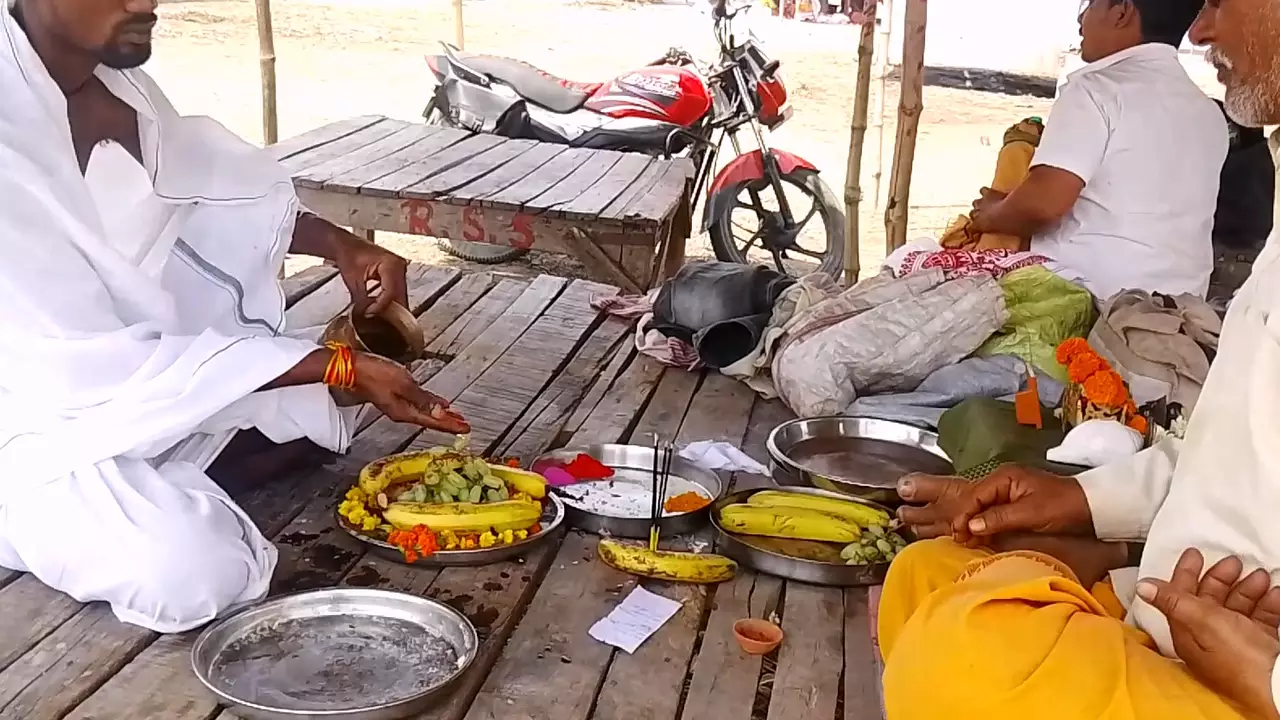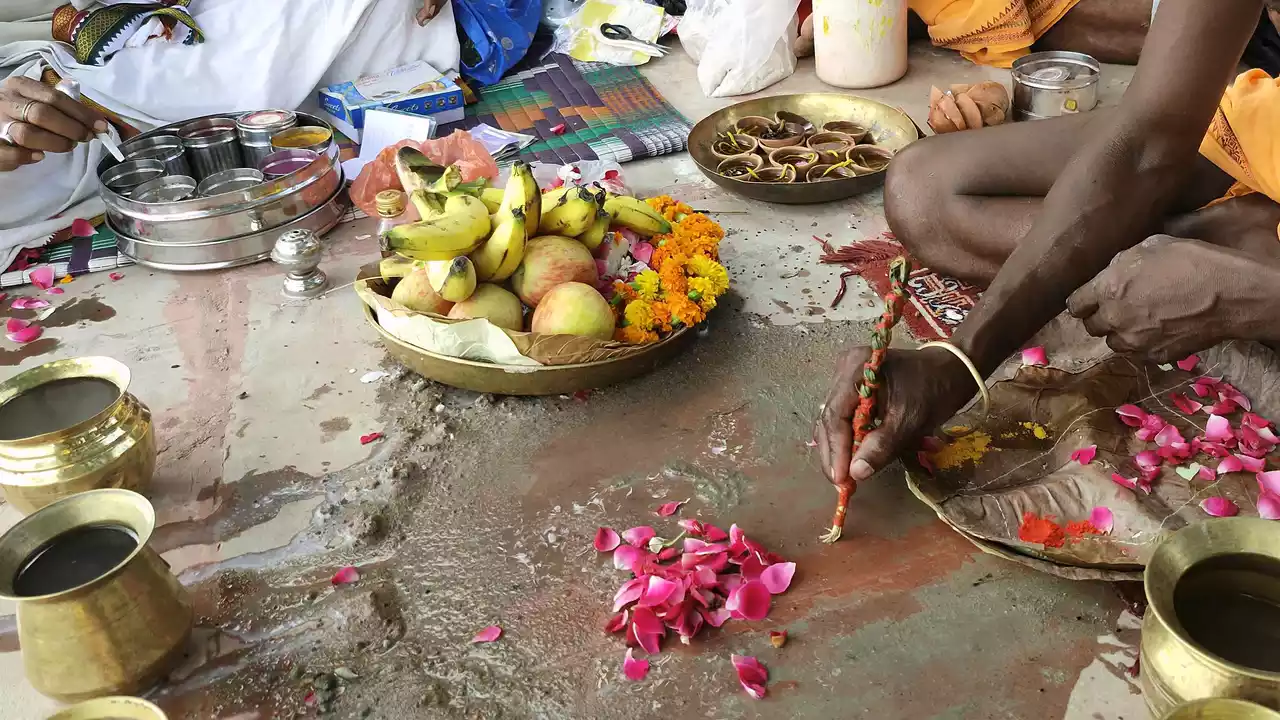Namaste,
To perform Shradh with true understanding, one must indeed know the divine entities invoked. Just as we honour the Pitris (ancestors), we must also honour the Devas who preside over and sanctify these sacred rites. The Vishwadevas in Shradh hold a position of utmost importance, acting as divine witnesses and protectors of the ceremony.
Drawing upon the wisdom whispered through ages and echoed in our revered Puranas. Knowing them deepens our Shraddha (faith) and ensures our offerings are made with the correct reverence.
Who are the Vishwadevas? Understanding These Important Deities in Shradh

Many performing Shradh might focus solely on the ancestors, unaware of the other divine presences they invoke. But the Shradh ritual is a complex interplay of energies, and the Vishwadevas are key participants, ensuring the sanctity and efficacy of the entire process.
Exploring the Origins: Who Are the Vishwadevas According to the Puranas?
Our sacred texts offer various accounts, all pointing towards their divine nature and connection to cosmic order (Dharma).
Children of Dharma and Vishva
- The Padma Purana’s Account: This Purana provides a clear lineage. It states there are ten Vishwadevas, identifying them as the sons of a celestial being named Vishva. Elsewhere, it clarifies their parentage further, stating they are the sons of Dharma (the embodiment of righteousness and cosmic law) and his wife Vishvi. Their lineage directly from Dharma underscores their role in upholding the righteousness of rituals like Shradh.
- The Ten Vishwadevas: The Padma Purana even lists their names:
- Vasu (Wealth, substance)
- Satya (Truth)
- Kratu (Ritual performance, intelligence)
- Daksha (Skill, competence)
- Kala (Time)
- Kama (Desire, love)
- Dhriti (Fortitude, determination)
- Kuru (Ancestor of the Kuru dynasty)
- Pururavas (Ancient king, known for virtue)
- Madrava (Possibly related to sweetness or exhilaration)
(Note: Some interpretations or textual variations might exist in the names)
- Linga Purana Confirmation: The Linga Purana also corroborates that the Vishwadevas were born to Vishva, reinforcing this aspect of their origin story.
- Markandeya Purana’s View: This ancient text describes the Vishwadevas as representing three distinct groups of Dharma’s sons, again emphasizing their fundamental connection to righteousness and cosmic order.
Connection to the Vasus (A Point of Clarification)
- Brahma Purana and the Vasus: You mentioned the Brahma Purana speaking of eight Vasus born to Dharmadeva and Vasu (Daksha’s daughter). The Vasus (Apa, Dhruva, Soma, Dhara/Dhava, Anila, Anala, Pratyusha, Prabhasa) are indeed another important group of deities often associated with nature’s elements and cosmic functions.
- Distinction: While both groups are linked to Dharma and sometimes mentioned together (as in the Skanda Purana hymns), the Vishwadevas are generally considered a distinct group of ten deities specifically invoked during Shradh. Think of them as specialized functionaries for this purpose, though related to the broader divine family stemming from Dharma.
So, primarily, we understand the Vishwadevas as ten divine sons of Dharma and Vishva/Vishvi, embodying virtues and cosmic principles, placing them perfectly as overseers of righteous rituals.
The Indispensable Role of Vishwadevas in Shradh Rituals

Their presence is not merely symbolic; it is integral to the procedure and success of the Shradh ceremony. Without properly invoking and honouring the Vishwadevas in Shradh, the ritual is considered incomplete.
Why Invoke the Vishwadevas? The Divine Witnesses and Protectors
- Guardians of the Rite: The Varaha Purana provides a crucial insight. It states that during Shradh, numerous subtle beings (Devas, Asuras, Gandharvas, Yakshas, etc.) observe the proceedings, looking for flaws. Importantly, it specifically lists the Vishwadevas as gods present at the ceremony. They act as divine witnesses, ensuring the ritual is performed correctly and with the required purity and devotion.
- Sanctifiers of the Offering: Their presence sanctifies the offerings and the space. They protect the ritual from disruptive subtle influences or negative energies that might try to interfere or steal the offerings intended for the Pitris.
- Upholders of Dharma: As sons of Dharma, their presence lends righteous authority to the Shradh. Invoking them aligns the ritual with cosmic law, ensuring its acceptance within the divine order.
- Facilitators: They are believed to help ensure that the offerings made actually reach the intended Pitris, acting as divine intermediaries or guarantors of the process.
How are Vishwadevas Represented and Honoured in the Ritual?
The procedure of Shradh explicitly incorporates the Vishwadevas:
- Separate Invitation: Traditionally, when Brahmins are invited for the Shradh meal, two Brahmins are often designated: one representing the Pitris (Pitri-sthaana) and another representing the Vishwadevas (Deva-sthaana). Sometimes, specific numbers are mentioned (e.g., three for Pitris, two for Vishwadevas).
- Kusha Representation: If suitable Brahmins are unavailable, representations are made using Kusha grass (Darbha). Two specific arrangements of Kusha grass (kusha-brahmana or chattas) are prepared, one designated for the Pitris and one for the Vishwadevas.
- Order of Service: Crucially, the Vishwadevas are typically invoked and offered worship before the Pitris. Offerings like water for washing feet (padya), water for sipping (achamaniya), scented water (arghya), flowers, incense, and food are first presented to the Brahmin or Kusha representing the Vishwadevas.
- Distinct Offerings: While black sesame seeds (krishna til) are predominantly used for offerings to Pitris, barley (yava) is often prescribed for offerings made to the Devas, including the Vishwadevas during Shradh. The food offered to the Deva-sthaana might also be placed on a different leaf or plate arrangement.
- Specific Mantras: Specific Vedic or Puranic mantras are recited to invoke the Vishwadevas, welcome them, make offerings to them, and seek their blessings.
This distinct representation and order of service clearly highlight the unique and essential place of the Vishwadevas in Shradh.
The Divine Stature and Cosmic Significance of the Vishwadevas
Their importance extends beyond the Shradh ritual, reflecting their status within the broader Hindu pantheon.
- Devoted Beings: The Skanda Purana shows they are not just passive recipients but active worshippers themselves. It mentions them worshipping a silver Linga, chanting the name Jagatam Pati (Lord/Protector of the Worlds), indicating their devotion, likely to Lord Shiva.
- Part of the Celestial Hierarchy: The Skanda Purana includes them in hymns of obeisance alongside other major divine groups like the Vasus, Rudras, and Adityas. It also lists them among the thirty-three prominent Devas (Suras) residing in holy places, affirming their high rank.
- Cosmic Influence: The Agni Purana assigns the Vishwadevas presidency over certain asterisms (nakshatras – specifically Uttara Ashadha), linking them to the celestial sphere, astrology, and the cosmic rhythms that govern time and events. This shows their influence permeates beyond earthly rituals into the workings of the cosmos.
Why Understanding the Vishwadevas Enhances Your Shradh Performance

Knowing who the Vishwadevas are and why they are invoked transforms the Shradh from a rote procedure into a deeply meaningful interaction with the divine.
- Deepens Shraddha: Recognizing that you are not only feeding your ancestors but also honouring powerful deities who witness and sanctify the act naturally deepens your faith and reverence (Shraddha).
- Ensures Correctness: Understanding their role prevents mistakes, like neglecting their invocation or offering Pitri-specific items (like black til) to the Deva-sthaana. Knowing the Vishwadevas in Shradh are invoked first guides the proper sequence.
- Adds Layers of Meaning: It elevates the Shradh beyond just personal ancestral duty to participation in a cosmic process, upheld by the sons of Dharma themselves. Your personal act resonates with universal principles of righteousness and order.
- Invokes Greater Blessings: By consciously honouring the Vishwadevas, you invoke their specific blessings for protection, purity, and the successful fruition of the Shradh, in addition to the blessings of the satisfied Pitris. Pleasing the sons of Dharma is akin to pleasing Dharma itself.
Conclusion: Honouring the Divine Witnesses of Shradh
So, the Vishwadevas are far more than just names on a list. They are a specific group of ten deities, born of Dharma and Vishva/Vishvi, embodying righteousness and cosmic principles. Their presence is mandated by scripture, like the Varaha Purana, as essential witnesses and sanctifiers of the Shradh ritual.
They are represented distinctly (often by a separate Brahmin or Kusha effigy), honoured before the Pitris, and receive specific offerings like barley. Understanding the role of the Vishwadevas in Shradh is crucial for performing the ceremony correctly and completely. They protect the rite, ensure the offerings reach the ancestors, and lend the authority of Dharma to your act of remembrance.
Therefore, when you next perform Shradh, invoke the Vishwadevas – Vasu, Satya, Kratu, Daksha, Kala, Kama, Dhriti, Kuru, Pururavas, and Madrava – with conscious reverence and gratitude. Know that you are honouring not only your lineage but also the divine guardians who uphold the sanctity of this sacred bridge between worlds. May their blessings, along with those of your Pitris, always illuminate your path.
||कल्याणमस्तु||
